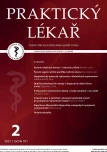Knowledge of nurses of disinfection of selected objects and surfaces in the provision of health services
Authors:
M. Krause 1,2; F. Dolák 1
Authors‘ workplace:
Jihočeská univerzita v Českých Budějovicích, Zdravotně sociální fakulta, Ústav ošetřovatelství, porodní asistence a neodkladné péče, Ředitelka: prof. PhDr. Valérie Tóthová, Ph. D.
1; Technická univerzita v Liberci, Fakulta zdravotnických studií, Ústav ošetřovatelství a neodkladné péče, Děkan: prof. MUDr. Karel Cvachovec, CSc., MBA
2
Published in:
Prakt. Lék. 2021; 101(2): 112-117
Category:
Of different specialties
Overview
Aim: The aim of the research was to find out the knowledge of general nurses about disinfection of selected non-critical or minimally critical objects and surfaces used in the provision of nursing care.
Method: For data collection was used a quantitative method of research using the questionnaire technique. The research was focused on general nurses working in standard departments of internal and surgical disciplines. The research was carried out in a regional hospital and took place from March to June 2020.
Results: By the research was positively found out that general nurses have knowledge about the indication of disinfection, the selection of a suitable disinfectant and the method of disinfection. However, the problem area was the knowledge about ensuring the appropriate concentration and exposure time of disinfectant. The results of the research show that it is important to regularly train general nurses in the chemical disinfection of objects and surfaces that are repeatedly used by general nurses in clinical practice.
Conclusion: An important aspect for performing disinfection of non-critical or minimally critical objects and surfaces is the knowledge of general nurses about disinfection. The results of the research obtained by the questionnaire survey thus form the basis for the implementation of regular training in problematics of healthcare associated infections, their prevention and compliance with the hygienic and epidemiological principles, and they are also the basis for the need to seek and implement new options to minimize the transmission of healthcare associated infections and for the provision of safe and quality care.
Keywords:
disinfection – objects and surfaces – healthcare associated infections – practice – general nurses – knowledge – Disinfection – objects and surfaces – healthcare associated infections – practice – general nurses – Knowledge
Sources
- WHO. Global guidelines for the prevention of surgical site infection. Geneva: World Health Organization 2018.
- Schmidt MG, Dessauer B, Benavente C, et al. Copper surfaces are associated with significantly lower concentrations of bacteria on selected surfaces within a pediatric intensive care unit. Am J Infect Control 2016; 44(2): 203–209.
- Suleyman G, Alangaden G, Bardossy A. The role of environmental contamination in the transmission of nosocomial pathogens and healthcare-associated infections. Curr Infect Dis Rep 2018; 20(6): 12.
- Russotto V, Cortegiani A, Raineri SM, Giarratano A. Bacterial contamination of inanimate surfaces and equipment in the intensive care unit. J Intensive Care 2015; 3: 54.
- Han JH, Sullivan N, Leas BF, et al. Cleaning hospital room surfaces to prevent health care-associated infections: a technical brief. Ann Intern Med 2015; 163(8): 598–607.
- Link T, Kleiner C, Mancuso MP, et al. Determining high touch areas in the operating room with levels of contamination. Am J Infect Control 2016; 44(11): 1350–1355.
- Sattar S. Cleaning, disinfection, and sterilisation. Portadown: International Federation of Infection Control 2016 [online]. Dostupné z: https://www.theific.org/wp-content/uploads/2016/04/12-Cleaning_2016.pdf [cit. 2021-02-14].
- Bellamy E. An audit of cleaning effectiveness using adenosine triphosphate (ATP) bioluminiscence assay following outbreaks of infection. J Infect Prev 2012; 13(5): 154–157.
- Vyhláška č. 306/2012 Sb. o podmínkách předcházení vzniku a šíření infekčních onemocnění a o hygienických požadavcích na provoz zdravotnických zařízení a ústavů sociální péče. In: Sbírka zákonů České republiky. Částka 109, s. 3954–3984.
- Hedlová D, Jindrák V, Malý M. Postupy prevence a kontroly infekcí. In: Jindrák V, a kol. Antibiotická politika a prevence infekcí v nemocnici. Praha: Mladá fronta 2014.
- Yanga D, Lin L, Guo P, et al. Flashlight contamination and effectiveness of two disinfectants in a stomatology hospital. Int J Nursing Sci 2017; 4(2): 169–172.
- Rutala W, Weber D. Disinfection, sterilization, and antisepsis: an overview. Am J Infect Control 2016; 44(5 Suppl): e1–6.
- Donskey CJ. Beyond high-touch surfaces: Portable equipment and floors as potential sources of transmission of health care-associated pathogens. Am J Infect Control 2019; 47: 90–95.
- WHO. Decontamination and reprocessing of medical devices for health-care facilities. Geneva: World Health Organization 2016.
- Matoušková I, Jurásková SE. Hygienicko-epidemiologický režim zubní a ortodontické ordinace. Praha: Grada Publishing 2017.
- Bowe E, Srivastava T, Masroor N, et al. Disinfection of noncritical equipment on units with high hospital-onset Clostridium difficile infections. Am J Infect Control 2019; 47(2): 220–221.
- PIDAC. Best practices for environmental cleaning for prevention and control of infections in all health care settings. Ontario: Public Health Ontario [online]. Dostupné z: https://www.publichealthontario.ca/-/media/documents/bp-environmentalcleaning.pdf?la=en [cit. 2021-02-14].
- Luebbert P, Chinnes L. Preventing healthcare-associated infections. Brentwood: HCPro 2015.
- Sahiledengle B. Decontamination of patient equipment: nurses’ self-reported decontamination practice in hospitals of southeast Ethiopia. BMC Res Notes 2019; 12(392): 1–7.
- Mann EE, Manna D, Mettetal MR. Surface micropattern limits bacterial contamination. Antimicrob Resist Infect Control 2014; 3(28): 1–8.
- Ndegwa S. Antimicrobial copper surfaces for the reduction of health care–associated infections in intensive care settings. Ottawa: Canadian Agency for Drugs and Technologies in Health 2015.
- Gonçalves L. Self-sterilizing ormosils surfaces based on photo -synzthesized silver nanoparticles. Colloids and Surfaces B: Biointerfaces 2018; 164(1): 144–154.
Labels
General practitioner for children and adolescents General practitioner for adultsArticle was published in
General Practitioner

2021 Issue 2
Most read in this issue
- A vegan patient: nutritional characteristic of plant-based diet
- History of infections – never ending story
- Hepatotoxic potential of nutritional and dietary supplements
- Knowledge of nurses of disinfection of selected objects and surfaces in the provision of health services
